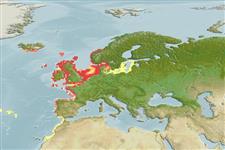Teleostei (teleosts) >
Eupercaria/misc (Various families in series Eupercaria) >
Labridae (Wrasses)
Etymology: Labrus: Name from Latin 'labrum' for lip, rim or edge; referring to the big lips of the fishes of the genus (from Ovid and Pliny according to Petrus Artedi)..
Environment: milieu / climate zone / depth range / distribution range
Ecology
Marine; reef-associated; depth range 1 - 50 m (Ref. 5292), usually 2 - 30 m (Ref. 35388). Temperate; 64°N - 27°N, 32°W - 22°E
Eastern Atlantic: Norway to Morocco, including Madeira, the Azores and the Canary Islands. Doubtful reports from Mediterranean, Adriatic and Marmara seas (Ref. 4742), where it is often confused with Labrus merula.
Length at first maturity / Size / Weight / Age
Maturity: Lm ? range ? - ? cm
Max length : 65.9 cm TL male/unsexed; (Ref. 40637); common length : 50.0 cm SL male/unsexed; (Ref. 4742); max. published weight: 4.4 kg (Ref. 40637); max. reported age: 29 years (Ref. 6843)
Body rather massive. Mouth small with thick lips and large conical teeth. Coloration very variable, brownish and greenish predominating (Ref. 35388).
Adults are found in littoral (10-20 m) zone around rocks, offshore reefs, and seaweed. Young often in intertidal areas. All are born females and change sex when they are 4-14 years old (Ref. 35388). One (or more) female spawns in nest of algae, built by male in a crevice. Feed on crustaceans and mollusks (Ref. 4742). Oviparous (Ref. 205).
Eggs are laid in nest built from algae; male guards nest 1-2 weeks until larvae hatch (Ref. 35388); larvae are pelagic.
Quignard, J.-P. and A. Pras, 1986. Labridae. p. 919-942. In P.J.P. Whitehead, M.-L. Bauchot, J.-C. Hureau, J. Nielsen and E. Tortonese (eds.) Fishes of the north-eastern Atlantic and the Mediterranean. UNESCO, Paris. Vol. 2. (Ref. 4742)
IUCN Red List Status (Ref. 130435)
Threat to humans
Harmless
Human uses
Fisheries: subsistence fisheries; gamefish: yes; aquarium: commercial
More information
ReferencesAquacultureAquaculture profileStrainsGeneticsElectrophoresesHeritabilityDiseasesProcessingNutrientsMass conversion
Tools
Special reports
Download XML
Internet sources
Estimates based on models
Preferred temperature (Ref.
123201): 8.7 - 13.3, mean 10.5 °C (based on 376 cells).
Phylogenetic diversity index (Ref.
82804): PD
50 = 0.5625 [Uniqueness, from 0.5 = low to 2.0 = high].
Bayesian length-weight: a=0.00955 (0.00546 - 0.01671), b=3.07 (2.92 - 3.22), in cm total length, based on LWR estimates for this species & (Sub)family-body (Ref.
93245).
Trophic level (Ref.
69278): 3.2 ±0.0 se; based on diet studies.
Resilience (Ref.
120179): Low, minimum population doubling time 4.5 - 14 years (K=0.1; tmax=29; tm=2-9).
Fishing Vulnerability (Ref.
59153): High to very high vulnerability (67 of 100).
Climate Vulnerability (Ref.
125649): High to very high vulnerability (75 of 100).
Nutrients (Ref.
124155): Calcium = 10.7 [4.4, 18.8] mg/100g; Iron = 0.168 [0.091, 0.360] mg/100g; Protein = 18.7 [15.8, 21.0] %; Omega3 = 0.302 [0.162, 0.565] g/100g; Selenium = 7.99 [3.73, 17.31] μg/100g; VitaminA = 54.7 [13.8, 262.4] μg/100g; Zinc = 0.647 [0.426, 1.163] mg/100g (wet weight);
